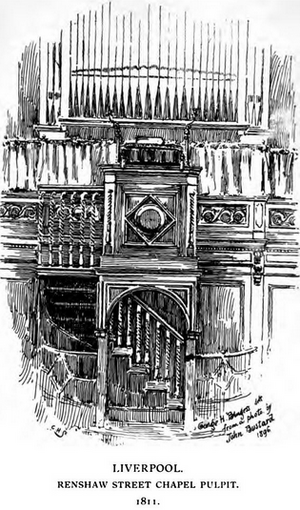Renshaw Street Unitarian Chapel facts for kids
The Renshaw Street Unitarian Chapel was a special church in Mount Pleasant, Liverpool, England. It was a place of worship for people who followed Unitarian beliefs. The chapel was open from 1811 until the 1890s. Many families who owned ships or worked in trade went to this chapel. These families often knew each other well and even married into each other's families.
Contents
How the Chapel Started
The Renshaw Street Unitarian Chapel began with a group of Presbyterian people. This group first met in a place called Toxteth Park around 1687. Later, they moved to another spot called Castle Hey. In 1727, they moved again to Benn's Gardens. When the new Unitarian chapel was built on Renshaw Street in 1811, the old Benn's Gardens building became a church for Welsh Wesleyan Methodists.
About the Building's Design
Many years after the church group moved out, one of their former leaders described the chapel's look. They said it was like "Puritanism turned into stone." This means the building was very plain and strong, not fancy or decorated. It was built to be useful for worship, like a strong fort. The design showed that God was seen as a "mighty fortress." This idea comes from an old German hymn. The building was simple and solid, showing its purpose clearly.
The People Who Attended
The new chapel on Renshaw Street had many important local families in its group. Some of these families were the Booths, Brunners, Gaskells, Holts, Rathbones, and Tates. These families were often involved in shipping and trade. The chapel was a meeting place for them. They were a very close group of Unitarian ship owners and merchants. They often formed partnerships by marrying each other. They also met socially and invested in each other's businesses.
These families shared their skills and worked together on many projects. They were very active in helping others, especially with education. They also took part in politics to bring about changes and improvements. For example, John Hamilton Thom, who was a minister at the chapel, was married to someone from the Rathbone family. He once described Emma Holt, from another rich Liverpool family, as someone who helped older people who needed support. Even though these families were very forward-thinking in politics, they were also quite exclusive in their social circles.
Moving to a New Location
In 1895, the church bought land for a new chapel. The group then moved to the new Ullet Road Unitarian Church in 1899. This new church was near Sefton Park. This move showed a bigger trend in Liverpool. Many wealthy business families were moving away from the busy city center. They preferred to live in the nicer, quieter areas on the edge of the city. Many members of the chapel built their homes in this new area.
Today, the Renshaw Street site is where the Grand Central Hall stands. However, the chapel's old graveyard is still there as a garden. There is also a monument that reminds people of the chapel that used to be there. The cemetery had been closed for new burials because of health rules. But Thomas Thornely, who died in 1862, was able to get special permission. He asked the prime minister, Lord Palmerston, to allow people closely related to those already buried there to be laid to rest. This was allowed under strict rules.
Important Ministers
- Charles Beard
- William Henry Channing
- George Harris
- William Hincks
- L. P. Jacks
- John Hamilton Thom
Important Members
- Henry Arthur Bright
- Sir John Brunner, 1st Baronet
- John Pemberton Heywood
- Samuel Holland
- Alfred Holt
- Emma Holt
- George Holt
- William Stanley Jevons
- William Lidderdale
- William Rathbone V
- William Rathbone VI
- William Roscoe
- Henry Tate
- Thomas Thornely
- John Ashton Yates


